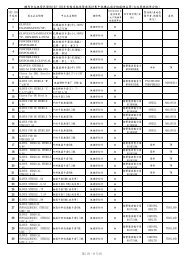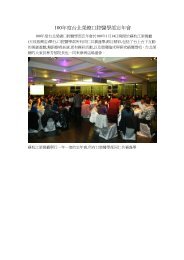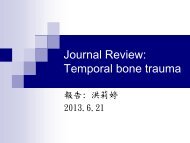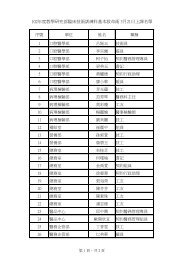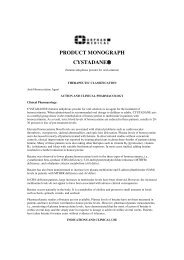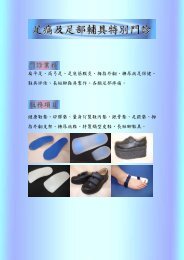Benign Paroxysmal Positional Vertigo
Benign Paroxysmal Positional Vertigo
Benign Paroxysmal Positional Vertigo
You also want an ePaper? Increase the reach of your titles
YUMPU automatically turns print PDFs into web optimized ePapers that Google loves.
R 葉建甫<br />
VS 黃啟原<br />
2013/01/11<br />
Taipei Veterans General Hospital
<strong>Benign</strong> <strong>Paroxysmal</strong> <strong>Positional</strong> <strong>Vertigo</strong> (BPPV)<br />
Introducion<br />
Pathogenesis<br />
Diagnosis<br />
Treatment<br />
Cho EI, White JA. <strong>Positional</strong> vertigo: as occurs across all age groups.<br />
Otolaryngol Clin. North Am. 2011 Apr;44(2):347-360.
BPPV: 17%~42% of vertigo<br />
Age: 50 Y/O ~ 70 Y/O<br />
Cho EI, White JA. <strong>Positional</strong> vertigo: as occurs across all age groups.<br />
Otolaryngol Clin. North Am. 2011 Apr;44(2):347-360.
Furman JM, Cass SP. <strong>Benign</strong> paroxysmal positional vertigo. N Engl J Med 1999;341:1590–6
18 Y/O: case reports<br />
minor head trauma<br />
(recurrent) family hx of migraine<br />
18~39 Y/O:<br />
yoga, running, reach high up, aerobic exercise,<br />
swim<br />
> 40 Y/O:<br />
head trauma, VN<br />
Cho EI, White JA. <strong>Positional</strong> vertigo: as occurs across all age groups.<br />
Otolaryngol Clin. North Am. 2011 Apr;44(2):347-360.
Posterior canal BPPV: 85~95%<br />
Horizontal canal BPPV: 5~15%<br />
Other (ant. canal, multiple canal): rare<br />
Bhattacharyya et al. Clinical practice guideline: <strong>Benign</strong> paroxysmal positional vertigo.<br />
Otolaryngology–Head and Neck Surgery (2008) 139, S47-S81
Posterior canal BPPV: canalithiasis<br />
Parnes et al. Diagnosis and management of benign paroxysmal positional vertigo (BPPV). CMAJ • SEPT. 30, 2003; 169 (7)
Posterior canal BPPV: canalithiasis<br />
Parnes et al. Diagnosis and management of benign paroxysmal positional vertigo (BPPV). CMAJ • SEPT. 30, 2003; 169 (7)
Parnes et al. Diagnosis and management of benign paroxysmal positional vertigo (BPPV). CMAJ • SEPT. 30, 2003; 169 (7)
<strong>Vertigo</strong>: changes head position relative to gravity<br />
Roll over in bed<br />
Tilt the head to look upward
Furman JM, Cass SP. <strong>Benign</strong> paroxysmal positional vertigo. N Engl J Med 1999;341:1590–6
R L<br />
Superior oblique m. Inferior rectus m.<br />
Furman JM, Cass SP. <strong>Benign</strong> paroxysmal positional vertigo. N Engl J Med 1999;341:1590–6
<strong>Vertigo</strong> + mixed torsional and vertical nystagmus<br />
Latency (1~20 seconds) between the completion of the<br />
Dix–Hallpike test and the onset of vertigo and nystagmus<br />
<strong>Vertigo</strong> and nystagmus increase and then resolve within<br />
10~60 seconds from onset of nystagmus<br />
Fatigability<br />
Furman JM, Cass SP. <strong>Benign</strong> paroxysmal positional vertigo. N Engl J Med 1999;341:1590–6
If clinical c/w BPPV<br />
Dix-Hallpike Test (-)<br />
Horizontal (lateral) canal BPPV?
Horizontal canal BPPV: canalithiasis<br />
cupulolithiasis<br />
Parnes et al. Diagnosis and management of benign paroxysmal positional vertigo (BPPV). CMAJ • SEPT. 30, 2003; 169 (7)
Bhattacharyya et al. Clinical practice guideline: <strong>Benign</strong> paroxysmal positional vertigo.<br />
Otolaryngology–Head and Neck Surgery (2008) 139, S47-S81
Horizontal canal BPPV<br />
Canalithiasis<br />
Horizontal canal BPPV<br />
Cupulolithiasis<br />
V. Honrubia et al. <strong>Paroxysmal</strong><br />
<strong>Positional</strong> <strong>Vertigo</strong> Syndrome.<br />
Am J Otol. 1999 Jul;20(4):465-70.<br />
Fife TD. Recognition and<br />
management of horizontal canal<br />
benign positional vertigo. Am J<br />
Otol. 1998 May;19(3):345-51.
Primary or Idiopathic (50%~70%)<br />
Secondary (30%~50%)<br />
• Head trauma (7%~17%)<br />
• Viral labyrinthitis (15%)<br />
• Ménière’s disease (5%)<br />
• Migraines (
Vestibular suppressant medication should be<br />
avoided<br />
Repositioning maneuver is recommended<br />
Posterior canal BPPV<br />
Canalith repositioning procedure (Epley’s maneuver)<br />
Liberatory maneuver (Semont’s maneuver)<br />
Horizontal canal BPPV<br />
Roll maneuver (Lempert maneuver or barbecue roll maneuver)<br />
Bhattacharyya et al. Clinical practice guideline: <strong>Benign</strong> paroxysmal positional vertigo.<br />
Otolaryngology–Head and Neck Surgery (2008) 139, S47-S81
Furman JM, Cass SP. <strong>Benign</strong> paroxysmal positional vertigo. N Engl J Med 1999;341:1590–6
Parnes et al. Diagnosis and management of benign paroxysmal positional vertigo (BPPV). CMAJ • SEPT. 30, 2003; 169 (7)
Fife TD, Iverson DJ, Lempert T, et al. Practice parameter: therapies for benign paroxysmal positional vertigo (an evidencebased<br />
review): report of the Quality Standards Subcommittee of the American Academy of Neurology. Neurology. 2008; 70:2067–2074.
Fig. 2<br />
A <strong>Positional</strong> Maneuver for Treatment of Horizontal-<br />
Canal <strong>Benign</strong> <strong>Positional</strong> <strong>Vertigo</strong>.<br />
Lempert, Thomas; Tiel-Wilck, Klaus<br />
Laryngoscope. 106(4):476-478, April 1996.<br />
Fig. 2 . <strong>Positional</strong> maneuver for treatment of HC-BPV.<br />
Each 90-degree head rotation is performed rapidly within<br />
a half second. Head positions are maintained for<br />
between 30 and 60 seconds until all nystagmus has<br />
subsided. A. Starting position: supine. B. Head rotation<br />
toward the unaffected ear. C. Body turn from supine to<br />
prone while head position is maintained. D. Head<br />
rotation to nose-down position.E. Final head turn to<br />
affected-ear-down position. F. Sitting-up position. X =<br />
affected ear (right side); RS = right shoulder.<br />
© The American Laryngological, Rhinological & Otalogical Society, Inc. Published by Lippincott Williams & Wilkins,<br />
Inc.<br />
2
<strong>Vertigo</strong> (~100%)<br />
Heaviness in head (65.52%)<br />
Nausea (37.93%)<br />
Vomiting (3.45%)<br />
Imbalance (37.93%)<br />
Palpitation (34.5%)<br />
Conversion to lateral canal BPPV (6~7%)<br />
Sridhar and Panda. Safety of Particle Repositioning Manoeuvre in <strong>Benign</strong> <strong>Paroxysmal</strong> <strong>Positional</strong> <strong>Vertigo</strong>: Is<br />
It Really Safe? The Journal of Otolaryngology, Volume 34, Number 1, 2005
Significant vascular disease<br />
Cervical stenosis<br />
Severe kyphoscoliosis<br />
Limited cervical range of motion<br />
Down syndrome<br />
Severe rheumatoid arthritis<br />
Cervical radiculopathies<br />
Paget’s disease<br />
Ankylosing spondylitis<br />
Low back dysfunction<br />
Spinal cord injuries<br />
Morbid obesity<br />
Bhattacharyya et al. Clinical practice guideline: <strong>Benign</strong> paroxysmal positional vertigo.<br />
Otolaryngology–Head and Neck Surgery (2008) 139, S47-S81



